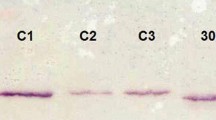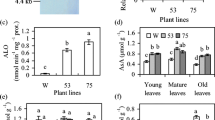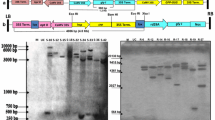Abstract
The accumulation of toxic compounds generated by the interaction between reactive oxygen species and polyunsaturated fatty acids of membrane lipids can significantly damage plant cells. A plethora of enzymes act on these reactive carbonyls, reducing their toxicity. Based on the chromosomal localization and on their homology with other stress-induced aldo–keto reductases (AKRs) we have selected three rice AKR genes. The transcription level of OsAKR1 was greatly induced by abscisic acid and various stress treatments; the other two AKR genes tested were moderately stress-inducible. The OsAKR1 recombinant protein exhibited a high nicotinamide adenine dinucleotide phosphate-dependent catalytic activity to reduce toxic aldehydes including glycolysis-derived methylglyoxal (MG) and lipid peroxidation-originated malondialdehyde (MDA). The function of this enzyme in MG detoxification was demonstrated in vivo in E. coli and in transgenic plants overproducing the OsAKR1 protein. Heterologous synthesis of the OsAKR1 enzyme in transgenic tobacco plants resulted in increased tolerance against oxidative stress generated by methylviologen (MV) and improved resistance to high temperature. In these plants lower levels of MDA were detected both following MV and heat treatment due to the activity of the OsAKR1 enzyme. The transgenic tobaccos also exhibited higher AKR activity and accumulated less MG in their leaves than the wild type plants; both in the presence and absence of heat stress. These results support the positive role of OsAKR1 in abiotic stress-related reactive aldehyde detoxification pathways and its use for improvement of stress tolerance in plants.







Similar content being viewed by others
Abbreviations
- ABA:
-
Abscisic acid
- AKR:
-
Aldo–keto reductase
- MDA:
-
Malondialdehyde
- MG:
-
Methylglyoxal
- MsALR:
-
Medicago sativa aldo–keto reductase
- MV:
-
Methylviologen
- NADPH:
-
Nicotinamide adenine dinucleotide phosphate
- qRT–PCR:
-
Quantitative real-time PCR
- PSII:
-
Photosystem II
- ROS:
-
Reactive oxygen species
- SDS–PAGE:
-
Sodium dodecyl sulfate polyacrylamide gel electrophoresis
- TBARS:
-
2-Thiobarbituric acid-reactive substances
References
Bartels D, Engelhardt K, Roncarati R, Schneider K, Rotter M, Salamini F (1991) An ABA and GA modulated gene expressed in the barley embryo encodes an aldose reductase related protein. EMBO J 10:1037–1043
Birnboim HC, Doly J (1979) A rapid alkaline extraction procedure for screening recombinant plasmid DNA. Nucl Acids Res 7:1513
Bohren KM, Page JL, Shankar R, Henry SP, Gabbay KH (1991) Expression of human aldose and aldehyde reductases. J Biol Chem 266:24031–24037
Bradford MM (1976) A rapid and sensitive method for the quantitation of microgram quantities of protein utilizing the principle of protein-dye binding. Anal Biochem 72:248–254
Bukhov NG, Wiese C, Neimanis S, Heber U (1999) Heat sensitivity of chloroplasts and leaves: leakage of protons from thylakoids and reversible activation of cyclic electron transport. Photosynth Res 59:81–93
Chang Q, Harter TM, Rikimaru LT, Petrash JM (2003) Aldo-keto reductases as modulators of stress response. Chem Biol Interact 325:143–144
Chang Q, Griest TA, Harter TM, Petrash JM (2007) Functional studies of aldo-keto reductases in Saccharomyces cerevisiae. Biochim Biophys Acta 1773:321–329
Chaoui A, Mazhoudi S, Ghorbal MH, El Ferjani E (1997) Cadmium and zinc induction of lipid peroxidation and effects on antioxidant enzyme activities in bean (Phaseolus vulgaris L.). Plant Sci 127:139–147
Chomczynski P, Sacchi N (1987) Single-step method of RNA isolation by acid guanidinium thiocyanate-phenol-chloroform extraction. Anal Biochem 162:156–159
Colrat S, Latche A, Guis M, Pech JC, Bouzayen M, Fallot J, Roustan JP (1999) Purification and characterization of a NADPH-dependent aldehyde reductase from mung bean that detoxifies eutypine, a toxin from Eutypa lata. Plant Physiol 119:621–626
De Ronde JAD, Cress WA, Kruger GHJ, Strasser RJ, Staden JV (2004) Photosynthetic response of transgenic soybean plants containing an Arabidopsis P5CR gene, during heat and drought stress. J Plant Physiol 61:1211–1244
Garretón V, Carpinelli J, Jordana X, Holuigue L (2002) The as-1 promoter element is an oxidative stress-responsive element and salicylic acid activates it via oxidative species. Plant Physiol 130:1516–1526
Gavidia I, Perez-Bermudez P, Seitz HU (2002) Cloning and expression of two novel aldo-keto reductases from Digitalis purpurea leaves. Eur J Biochem 269:2842–2850
Goff SA (1999) Rice as a model for cereal genomics. Curr Opin Plant Biol 2:86–89
Gong M, Li JY, Chen SZ (1998) Abscisic acid induced thermotolerance in maize seedlings is mediated by Ca2+ and associated with antioxidant systems. J Plant Physiol 153:488–496
Gounaris K, Brain AR, Quinn PJ, Williams WP (1984) Structural reorganization of chloroplast thylakoid membranes in response to heat stress. Biochim Biophys Acta 766:198–208
Grant AW, Steel G, Waugh H, Ellis EM (2003) A novel aldo-keto reductase from E. coli can increase resistance to methylglyoxal toxicity. FEMS Microbiol Lett 218:93–99
Halder AB, Crabbe MJ (1984) Bovine lens aldehyde reductase (aldose reductase). Purification, kinetics and mechanism. Biochem J 219:33–39
Hegedűs A, Erdei S, Janda T, Tóth E, Horváth G, Dudits D (2004) Transgenic tobacco plants overproducing alfalfa aldose/aldehyde reductase show higher tolerance to low temperature and cadmium stress. Plant Sci 166:1329–1333
Hideg É, Nagy T, Oberschall A, Dudits D, Vass I (2003) Detoxification function of aldose/aldehyde reductase during drought and ultraviolet-B (280–320 nm) stresses. Plant Cell Environ 26:513–522
Horsch RB, Fry JE, Hoffmann EL, Eichholtz D, Rogers SG, Fraley RT (1985) A simple and general method for transferring genes into plants. Science 227:1229–1231
Hsieh T-H, Lee J-T, Charng Y-Y, Chan M-T (2002) Tomato plants ectopically expressing Arabidopsis CBF1 show enhanced resistance to water deficit stress. Plant Physiol 130:618–626
Hur J, Jung KH, Lee CH, An G (2004) Stress-inducible OsP5CS2 gene is essential for salt and cold tolerance in rice. Plant Sci 167:417–426
Igarashi Y, Yoshiba Y, Sanada Y, Yamaguchi-Shinozaki K, Wada K, Shinozaki K (1997) Characterization of the gene for delta1-pyrroline-5-carboxylate synthetase and correlation between the expression of the gene and salt tolerance in Oryza sativa L. Plant Mol Biol 33:857–865
Jez JM, Bennett MJ, Schlegel BP, Lewis M, Penning TM (1997) Comparative anatomy of the aldo–keto reductase superfamily. Biochem J 326:625–636
Kasuga M, Liu Q, Miura S, Yamaguchi-Shinozaki K, Shinozaki K (1999) Improving plant drought, salt and freezing by gene transfer of a single stress-inducible transcription factor. Nat Biotechnol 17:287–291
Kikugawa K, Tsukuda K, Kurechi T (1980) Studies on peroxidized lipids. I. Interaction of malondialdehyde with secondary amines and its relevance to nitrosamine formation. Chem Pharm Bull 28:3323–3331
Kolb NA, Hunsaker LA, Vander Jagt DL (1994) Aldose reductase catalyzed reduction of acrolein: implication in cyclophasphamide toxicity. Mol Pharmacol 45:797–801
Kumar S, Dhingra A, Daniell H (2004) Plastid-expressed betaine aldehyde dehydrogenase gene in carrot cultured cells, roots, and leaves conferes enhanced salt tolerance. Plant Physiol 136:2843–2854
Kwon SY, JeongYJ LeeHS, Kim JS, Cho KY, Allen RD, Kwak SS (2002) Enhanced tolerance of transgenic tobacco plants expressing both superoxide dismutase and ascorbate peroxidase in chloroplasts against methylviologen-mediated oxidative stress. Plant Cell Environ 25:873–882
Larkindale J, Knight MR (2002) Protection against heat stress-induced oxidative damage in Arabidopsis involves calcium, abscisic acid, ethylene and salicylic acid. Plant Physiol 128:682–695
Lendvai A, Pettkó-Szandtner A, Csordás-Tóth E, Miskolczi P, Horváth GV, Györgyey J, Dudits D (2007) Dicot and monocot plants differ in retinoblastoma-related protein subfamilies. J Exp Bot 58:1663–1675
Li Z, Murai N (1990) Efficient plant regeneration from rice protoplasts in general medium. Plant Cell Rep 9:216–220
Livak KJ, Schmittgen TD (2001) Analysis of relative gene expression data using real-time quantitative PCR and the 2−∆∆CT method. Methods 25:402–408
Mano J, Belles-Boix E, Babiychuk E, Inzé D, Torii Y, Hiraoka E, Takimoto K, Slooten L, Asada K, Kushnir S (2005) Protection against photooxidative injury of tobacco leaves by 2-alkenal reductase. Detoxication of lipid peroxide-derived reactive carbonyls. Plant Physiol 139:1773–1783
Mano J, Miyatake F, Hiraoka E, Tamoi M (2009) Evaluation of the toxicity of stress-related aldehydes to photosynthesis in chloroplasts. Planta 230:639–648
Mano J, Tokushige K, Mizoguchi Hirotoshi, Fujii H, Khorobrykh S (2010) Accumulation of lipid peroxide-derived, toxic α,β-unsaturated aldehydes (E)-2-pentenal, acrolein and (E)-2-hexenal in leaves under photoinhibitory illumination. Plant Biotech 27:193–197
Martins AMTBS, Cordeiro CAA, Freire AMJP (2001) In situ analysis of methylglyoxal metabolism in Saccharomyces cerevisiae. FEBS Lett 499:41–44
Mishra RK, Singhal GS (1992) Function of photosynthetic apparatus of intact wheat leaves under high light and heat stress and its relationship with peroxidation of thylakoid lipids. Plant Physiol 98:1–6
Mundree SG, Whittaker A, Thomson JA, Farrant JM (2000) An aldose reductase homolog from the resurrection plant Xerophyta viscosa Baker. Planta 211:693–700
Murashige T, Skoog F (1962) A revised medium for rapid growth and bioassays with tobacco tissue cultures. Physiol Plant 15:473–497
Oberschall A, Deák M, Török K, Sass L, Vass I, Kovács I, Fehér A, Dudits D, Horváth GV (2000) A novel aldose/aldehyde reductase protects transgenic plants against lipid peroxidation under chemical and drought stress. Plant J 24:437–446
Ray S, Dutta S, Halder J, Ray M (1994) Inhibition of electron flow through complex I of the mitochondrial respiratory chain of Ehrlich ascites carcinoma cells by methylglyoxal. Biochem J 303:69–72
Rodrigues SM, Andrade MO, Gomes AP, Damatta FM, Baracat-Pereira MC, Fontes EP (2006) Arabidopsis and tobacco plants ectopically expressing the soybean antiquitin-like ALDH7 gene display enhanced tolerance to drought, salinity, and oxidative stress. J Exp Bot 57:1909–1918
Roncarati R, Salamini F, Bartels D (1995) An aldose reductase homologous gene from barley: regulation and function. Plant J 7:809–822
Schreiber U, Schliwa U, Bilger W (1986) Continuous recording of photochemical and nonphotochemical chlorophyll fluorescence quenching with a new type of modulation fluorometer. Photosynth Res 10:51–62
Shimamoto K, Kyozuka J (2002) Rice as a model for comparative genomics of plants. Annu Rev Plant Biol 53:399–419
Simpson PJ, Tantitadapitak C, Reed AM, Mather OC, Bunce CM, White SA, Ride JP (2009) Characterization of two novel aldo-keto reductases from Arabidopsis: expression patterns, broad substrate specificity, and an open active-site structure suggest a role in toxicant metabolism following stress. J Mol Biol 392:465–480
Sree BK, Rajendrakumar SV, Reddy AR (2000) Aldose reductase in rice (Oryza sativa L.): stress response and developmental specificity. Plant Sci 160:149–157
Srivastava S, Watowich SJ, Petrash JM, Srivastava SK, Bhatnagar A (1999) Structural and kinetic determinants of aldehyde reduction by aldose reductase. Biochemistry 38:42–54
Srivastava SK, Ramana KV, Bhatnagar A (2005) Role of aldose reductase and oxidative damage in diabetes and the consequent potential for therapeutic options. Endocrin Rev 26:380–392
Sunkar R, Bartels D, Kirch HH (2003) Overexpression of a stress-inducible aldehyde dehydrogenase gene from Arabidopsis thaliana in transgenic plants improves stress tolerance. Plant J 35:452–464
Suzuki N, Mittler R (2006) Reactive oxygen species and temperature stresses: a delicate balance between signaling and destruction. Physiol Plant 126:46–51
Thompson LK, Blaylock R, Sturtevant JM, Brudwig GW (1989) Molecular basis of heat denaturation of photosystem II. Biochemistry 28:6686–6695
Vander Jagt DL, Robinson B, Taylor KK, Hunsaker LA (1992) Reduction of trioses by NADPH-dependent aldo-keto reductases. Aldose reductase, methylglyoxal, and diabetic complications. J Biol Chem 267:4364–4369
Xiang C, Miao ZH, Lam E (1996) Coordinated activation of as-1 type elements and a tobacco glutathione S-transferase gene by auxins, salicylic acid, methyl-jasmonate and hydrogen peroxide. Plant Mol Biol 32:415–426
Yadav SK, Singla-Pareek SL, Ray M, Reddy MK, Sopory SK (2005) Methylglyoxal levels in plants under salinity stress are dependent on glyoxalase I and gluthatione. Biochem Biophys Res Commun 337:61–67
Yamauchi Y, Sugimoto Y (2010) Effect of protein modifcation by malondialdehyde on the interaction between the oxygen-evolving complex 33 kDa protein and photosystem II core proteins. Planta 231:1077–1088
Yamauchi Y, Furutera A, Seki K, Toyoda Y, Tanaka K, Sugimoto Y (2008) Malondialdehyde generated from peroxidized linolenic acid causes protein modification in heat stressed plants. Plant Physiol Biochem 46:786–793
Zhu J-K (2001) Plant salt tolerance. Trends Plant Sci 6:66–71
Acknowledgments
Authors would like to acknowledge the help of Dr. Éva Hideg in the theoretical and practical aspects of the photosythetic measurements. This research was supported by the Hungarian National Office for Research and Technology (NKTH) (NKFP Grant No. 4-064-2004), OMFB Grant No. 00514/2007 and by the Baross Gábor Program 2009 (Grant No. REG_DA_KFI_09 ALDEHID9). Gábor V. Horváth is grateful for the support of the “János Bólyai” Research Fellowship.
Author information
Authors and Affiliations
Corresponding author
Rights and permissions
About this article
Cite this article
Turóczy, Z., Kis, P., Török, K. et al. Overproduction of a rice aldo–keto reductase increases oxidative and heat stress tolerance by malondialdehyde and methylglyoxal detoxification. Plant Mol Biol 75, 399–412 (2011). https://doi.org/10.1007/s11103-011-9735-7
Received:
Accepted:
Published:
Issue Date:
DOI: https://doi.org/10.1007/s11103-011-9735-7




